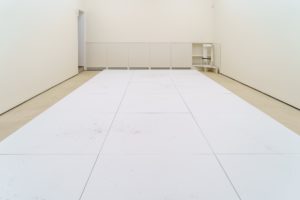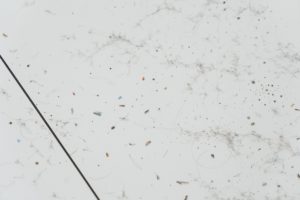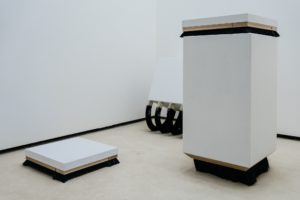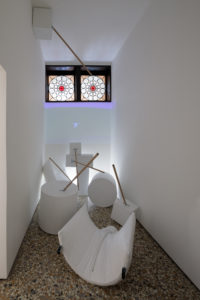Dream Compass: “There You Are,” or the Bulgarian Pavilion in the Context of the 59th Venice Biennial
“Images are (…) a silent language. They are a station on the way from silence to language. They stand on the frontier where silence and language face each other closer than anywhere else, but the tension between them is resolved by beauty. Images and pictures remind man of life before the coming of language. They move him with a yearning for that life (…) It is the soul that preserves the silent images of things”.(Max Picard, Images and Silence, in The World of Silence (Minnesota: Harvill, 1948), p. 80.)
The Bulgarian Pavilion at the 59th edition of the Venice Biennial houses the work There You Are by the artist Michail Michailov. In conversation with the pavilion’s curator Irina Batkova, Michailov formulated his own response to the topic proposed by Cecilia Alemani as an overarching theme for this edition of the biennial: The Milk of Dreams, inspired by the short stories of the artist Leonora Carrington (1917-2011). Michailov and Batkova’s interpretation of Alemani’s framework takes the form of site-specific work, realized in the exhibition space Spazio Ravà in San Polo – one of Venice’s oldest quarters, which first emerged in 1097 around a thriving marketplace. This article aims to explore the exhibition’s “capacity for development,”(According to Giorgio Agamben’s definition of the problem “The genuinely philosophical element contained in a work—be it an artistic, scientific, or theoretical work—is its capacity to be developed, something that has remained—or has willingly been left—unspoken and that needs to be found and seized.”; See Giorgio Agamben, Creation and Anarchy: The Work of Art and the Religion of Capitalism(Stanford: Stanford University Press, 2019), p. 15.) by exploring the fusion of hermeneutic horizons founded on a creative process of questioning the Bulgarian pavilion’s underlying meanings. Michailov’s work presents a philosophical challenge to viewers, one that is closely linked to Alemani’s framework for the biennial as a whole: only the person who dreams can interpret their dreams, think in multiple dimensions, and rebel against the dictate of their conscious mind, overcoming their “innate thought structures” (as Michailov puts it) and their personal fears and obsessions in order to reach—through daily rediscovery and transformation—harmonious relations with these emotions and with themselves.

Michail Michailov, Just Keep on Going, 2021. Video. Installed under Dust to Dust, drawing. Photo by Lisa Rastl.
In her curatorial statement for the biennial, Alemani explains that Carrington’s book functions in the duality between a“perception of a universe of endless possibilities” and an “allegory of a century that imposes an unbearable pressure on identity.”(Cecilia Alemani, “Statement,” https://www.labiennale.org/en/art/2022/statement-cecilia-alemani.) Alemani adds that Carrington’s stories outline a horizon of a world without hard objects or identities, whose driving law is transformation, stemming from a system of symbiotic dependencies. This magical world, with a physics that is closer to the quantum than to Newtonian, allows the possibility of becoming different from your own self.This curatorial concept provokes participating artists to suggest creative reflections on the posthuman state of the world and the end of the anthropocentric thought model, questioning the modern, Western vision of the human being.(Beyond Alemani’s interpretation, such a question is not surprising for thinkers in the humanities. Ancient Egyptians, for instance, conceived of the human being through a multifold framework that far exceeds the Western understanding (which is based on the Greek-Roman division of soul and body). For ancient Egyptians, the concept of the human is related to the complex and dynamic constellation between Ba (the soul), Ka (the double), the Akh (the merger between Ba and Ka that lives in the afterlife, liberated from the physical body), the Ib (the heart which in the bowl of Osiris is measured on the scales of the goddess Maat (the Truth), to understand how righteous was a person’s life), the Hati (the physical heart which remained in the mortal body during mumification); the Hat (the mortal sheath of a man, that is the vessel of Ka and Akh); and the Sah (the spiritual body, “the sacred remains” after mumification).) Humanity now faces a situation in which the universal idea of the “subject of reason” (dating back to the Enlightenment period, and most commonly interpreted as the white male individual)—formerly usually seen as the center of the universe and the measure for all things—is no longer credible. Technologies, pandemics, and ecological challenges are among the factors, according to Alemani, that put into question the power, self-sufficiency, and invincibility of the human consciousness locked in fragile and mortal bodies. Alemani proposes that the way out of the crisis of the illusionary power of consciousness is to be found in the spaces of imagination—a territory that we traditionally associate with sleep, dreams, and mythology, yet also with art and creativity.
The confrontation with the Enlightenment concept of the human inevitably implicates our understanding of related categories such as “art” and “artwork.” This intertwinement of artwork and consciousness is, in my opinion, the key thematic of Michailov’s There You Are. Michailov addresses Alemani’s philosophical dilemmas through a minimalistic system of expression, realized by transforming the architecture of Spazio Ravà into an experimental artistic environment of unrecognizable dimensions, without completely consigning to oblivion the dining room and its adjacent premises, situated on the first floor of a bourgeois Neogothic Venetian house of the christianised Jewish family Ravà. In its development, the work within the space acts in multiple directions, involving a wide spectrum of artistic tools used in Michailov’s previous projects: drawings, installations, videos, and performance. This approach requires the spectator to undertake multiple readings, providing the intuition for my own present interpretation of There You Are, which aims to think the work in its multiplicity.

Michail Michailov, Dust to Dust, color pencil drawings. Photo by Kalin Serapionov.
Michail Michailov was born in 1978, during the late communist years. He studied Fine Arts during the so-called Transition period in Bulgaria, when he was trained in classical academic painting at the Faculty of Fine Arts of the St. Cyril and St. Methodius University of Veliko Turnovo. He started his professional artistic career in Austria, where he graduated in Art History from the University of Vienna, taking part in several projects in cooperation with the artist group Gelitin and working on solo and group art projects. In 2012 he was already identified as one of the noteworthy Bulgarian artists in the Vienna contemporary art scene.(Maria Vassileva, ed., Bulgarian Artists in Vienna: Contemporary Practices at the Beginning of the 21st Century (Sofia: Sofia City Art Gallery, 2013), pp. 106-117.) Michailov’s work over the past two decades is multidisciplinary: he works across a broad range of visual media, but he is probably most famous for his performances as well as his hyperrealist drawings of dust, stains, useless plastic pieces, and mold.
Michailov’s artistic approach is subversive and usually includes profound symbolism, often imposed through clandestine actions that are mostly based upon the intermediary position of the protagonist. The artist utilizes strategies of camouflage and transformation that involve changing reality, disclosure, and intervention. His work also uses white as an essential color, as the fabric for his means of expression. “White is a link, a blank piece of paper, which makes every little particle visible,” as he puts it.(Maria Vassileva and Michail Michailov, “The Distinction between Real and Drawn Dust,” April 2020, www.structura.gallery/en/publications/michail-michailov/.) “I use color in relation to the question of who I am and who or what I am not, or whether I am everything that surrounds me or none of it. I am fascinated by the undescribed, the pure, the undefined. … In this way the insignificant [and] the unconscious acquires meaning.” (Erwin Uhrmann, excerpt from the exhibition catalogue Austria Contemporary 2009, in Bulgarian Artists in Vienna: Contemporary Practices at the Beginning of the 21st Century (Sofia: Sofia City Art Gallery, 2013) p. 110.) In his performances, the artist often wears a white protective suit, aiming to depersonalize his body and to minimize his physical presence in the environment. These suits are reminiscent of the protective suits used in criminology, or of medical or work overalls. Michailov applies this same white dress-up strategy to unnecessary objects as well, with the aim of breaking our everyday, habitual thought structures.
In There You Are, the color white is used as a form of camouflage to hide the physical space of Spazio Ravà, “bleaching”the original furniture and lighting it into obliteration in such a way that both vestibules (one facing the street and one facing the courtyard), the dining room, and the storage room lose their outlines and merge with the various elements of the artwork—the drawings, objects, a screen, and a wall upon which moving images are projected. These elementssometimes emerge vividly and intensely to the gaze; at other times they are as dreamy as dreams themselves. The imagery is developed as minimalistic and pedantic in order to create therapeutic world, in which the color white hints at an unquenchable desire for purification and alludes various states of passage and transformation.

Michail Michailov, Just Keep on Going #13 amd #14, video. 7-minute loop, 2021. Copyright Michail Michailov.
A good understanding of the There You Are project requires tracing the link between the exhibition at the Venice Biennale and some of the artist’s prior works. There You Are can be seen as an independent semiosphere born through a synthesis between components and approaches used in several ongoing projects Michailov has developed as a series over the past decade. The earliest of these is the Just Keep on Going video series, developed by the artist since 2010, in which he aims to approach “the fundamental question [of] who we really are.”(www.michailmichailov.com/Just-keep-on-going.) At Spazio Ravà, Michailov shows videos No 13 and No 14 from this series, developed especially for the pavilion and projected, respectively, on the wall of the storage room and beneath one of the drawings on the floor in the vestibule facing the courtyard.

Michail Michailov, Dust to Dust, color pencil drawings (fragment). Photo by Kalin Serapionov.
The second long-term project connected to There You Are is the series of drawings Dust to Dust, in which Michailov has been dealing with the important questions of life and existence since 2014.(www.michailmichailov.com/Dust-to-dust.) These drawings are based on a close observation of the micro-level of the visible world, and they focus on the unconscious. They aim to transform the incidental, the overlooked, the unwanted, and the repulsive into objects of desire. For the Bulgarian pavilion, Michailov has created a large-scale colored-pencil drawing of detritus (comprised of 18 modules grouped in 3 rolls and 6 lines, where each module measures one square meter) provoked by the physical context of the central space of Spazio Ravà, which originally served as the dining room of the house. There are also two smaller detritus drawings exhibited in both vestibules of the exhibition space. The modules are grouped on the floor to show the chameleon-like character of the drawings, which take the shape of the exhibition premises themselves.
The third long-term artistic project entwined within There You Are is the series of performative installations entitled Headspacing (in progress since 2018).(www.michailmichailov.com/Headspacing-1.) Headspacing is a white mobile architecture that extends Michailov’s imagination across different public spaces in Paris, Sofia, and Vienna by creating a spatial extension of the space around the artist’s own head. The installation examines the demarcation and fluid boundaries between the artist’s mind and body, between conscious and unconscious, and between intimate and public spaces. At Spazio Ravà, this mobile architecture is oriented from outside (the courtyard) towards the inside (the exhibition space itself).

Michail Michailov, Cleaning Pedestals. Installation. Photo by Kalin Serapionov.
The fourth prior artwork integrated into There You Are is the Cleaning Pedestals series (in progress since 2020), where Michailov questions the rules and presumptions of the artistic gaze by drawing attention to two of the normally invisible tools of artistic practice: the brush and the pedestal. Both are transformed into exhibition objects themselves, intimating a profound transformation of their essence and functions. In There You Are, these objects shape meditative areas of ritual purification: the pedestals, for example, are positioned to shape the spectator’s first entrance into the space. Finally, on the ceiling of the anteroom Michailov has displayed three colored-pencil drawings created for the pavilion under the title Heaven Panels, from his series Weak Points (2021-ongoing), a study of the parallelism between the weak points of architecture and those of the mind. (www.michailmichailov.com/Heaven-panels.)

Michail Michailov, Heaven Panels, color pencil drawings. Photo by Lisa Rastl.
Within the exhibition’s geometry, the title There You Are takes on the function of an idiosyncratic compass. It refers to the broad questions posed by Alemani, without providing a definitive answer to them. The ostensible marking of the place where the spectator finds themself—a certain “there you are!” —provokes the consciousness, but also the body of the spectator. The visitor is not only forced to pay more attention to the imaging regimes within the exhibition, but also to physically interact with these regimes – glimpsing, squatting, gazing upwards, downwards, under, and above them. The catalogue of the pavilion—in addition to the dialogues between the artist and the curator—contains an earlier text by Giorgio Agamben, entitled “The Idea for the Unmemorable,” in which the Italian thinker formulates the thesis that “sleep and remembrance immerse life in words and thus keep it out of reach for memory,” and namely “in sleep the unmemorable and unforgettable enter in a particular indistinguishability and mutually transform each other.”(Giorgio Agamben, Idea of Prose (New York; Suny Press, 1995).)
The regimes of imagination set by this year’s exposition for the Bulgarian Pavilion may be approached in a similar way to the entrances of the same building that houses it. Perhaps for this reason, the curator of the pavilion finds it necessary to mark—in the catalogue of the project—the possible entrances to Spazio Ravà: “The house may be accessed through the garden which is opened only for special cases, or through an entrance in the typical for this city small tunnels under the buildings which connect the already confusing labyrinth of streets.”(Irina Batkova, There You Are, exh cat (Sofia: National Art Gallery, 2022).) The intuition of my present interpretation is that the work invites us to access it not frontally, but rather to take the surrounding roads following the labyrinth effect of Venice.

Michail Michailov, Headspacing. Photo by Lisa Rastl.
An important aspect of the reflection on Michailov’s exhibition in Spazio Ravà is that in contrast to previous work of the artist (which has been more focused on objects),(In contrast to Michailov’s work up to now, which has been concentrated on precise work with objects, now his effort is focused on the geometry of space. However, There You Are nonetheless raises questions on which the artist has already worked in the previous years. For instance, in the artist’s 2021 project in +359 Gallery—entitled In search of the answer to the questions: Who are we? and Who are we not? —he transformed costumes into new “therapeutic sculptures”, whose aim is to break the innate thought structures of consciousness. Objects discarded in the street and found by the artist were enveloped in absorbing cotton and covered in protective clothing, which, in the opinion of the exhibition curator Hannes Anderle, created new and unimaginable constructions and relations to provoke the spectator into a new appreciation.) There You Are emphasizes the space itself—not only in terms of its physical parameters, but also in the philosophical sense of a “world”: a site of pre-existing, pre-reflexive relations, thoughtful and physical traces of our and others’ actions into which each of us is thrown.
Thus, There You Are delineates not only a place of questioning who are we, where we come from, and where are we headed to. This experimental site also literally and metaphorically combines the hyper-realistic drawing of the otherwise unnoticeable micro-traces of existence (the quasi-religious allusion in the title of the series of drawings Dust to Dust appears not accidental), unmemorable dreams, vague memories, unclear but also brave daring, fantasies and phantoms, delusions and chimeras, still transforming in the processes of dreaming, sleeping, and fantasizing. All these traces are arranged not on, but around the specific “purifying” pedestals mentioned above, which are turned into central objects of the exhibition space. In short, within this space the spectator sets out upon a journey in which the main role is played by their own imagination.
The architectonics of the work and the elements included challenge our usual spatial concepts (inside and out, up and down, and so forth). Captured in this environment, immersed in different emotions and passions, the consciousness—in its wish to possess the objects of the world—is challenged by temporal windows that open suddenly, accidentally clashing with lost, forgotten, and suppressed (now needless and unwanted, mental and visual) traces of existence.

Michail Michailov, Headspacing. Photo from Michail Michailov’s archive.
On its own terms, the expansion of the architecture applied in Headspacing dismembers the psychosomatics of the person who has found themselves in this position, by catching their head in artistic architectonics and removing their body, which remains in a space external to the artistic world. In the case of There You Are the space into which Michailov’s architectural intervention expands is a certain “natural” space: the inner courtyard of Spazio Ravà. This creates the illusion of a unique small bourgeois domesticated model of the Paradise on Earth—a myth that served as a resiliently compensatory dream for the modern Western person, voluntarily alienated from their connection to nature, which they have turned into an object of domestication and control.(Regarding the imagery interpretations of the myth of Paradise on Earth, see Angel Angelov, Anti Modernität. Bilder des Exotischen und des Paradieses auf Erden in Europa im 19. Jahrhundert (Sofia: Samizdat, 2019).) Accidentally or not, the inner courtyard of Spazio Ravà faces the Grand Canal—itself the symbol of prosperity, commercial power, and traffic of the Republic of Venice, spreading its influence to the furthest corners of the world. It is as if the mythologem of Paradise on Earth is being awoken and afterwards parenthesized through the dismemberment of the body of the artist/spectator, during which their gaze is directed towards the interior and integrated into the space of compatibility, while the body remains in the “natural” world of the inner courtyard (so rare for Venetian architecture).
Against this background, Michailov also chose to dress the invigilators of the exhibition in special white suits that perfectly integrate their bodies into the artistic environment, to a degree rendering them invisible. Thus, they also manage to be at once here and there in the space of the exhibition—fixed and immobile in their specifically designated places, while also supportively showing spectators the accents, directions, and meanings of Michailov’s work.
This approach allows Michailov to work on the borderline of the image, constituting it as a psychosomatic frontier between the conscious, unconscious, physicality, imagination, and the world. There You Are manages to operate as a “creative act” par excellence as defined by Giorgio Agamben. I am referring here to Agamben’s idea of the creative act defined as an act of resistance to the potential (being-able-to) and impotentiality (being-able-not-to, the potential-not-to)—that power of not advancing to the act, that essentially defines power as a whole, which I consider key to my understanding of There You Are’s answers given to Alemani’s main questions. Clarifying this idea, Agamben invites us “…to look at the act of creation as a field of forces stretched between potential and impotential, being-able-to and being-able-not-to, acting and resisting….”(Giorgio Agamben, What Is the Act of Creation?, in Creation and Anarchy: The Work of Art and the Religion of Capitalism (Stanford: Stanford University Press, California, 2019), p. 20.) As if to support the proximity between Michailov’s artistic approach and Agamben’s (contra-) aesthetic thoughts, another one of Agamben’s essays, “The Idea of the Unmemorable,” was published by curator Irina Batkova in the catalogue to the project.

Michail Michailov, Cleaning Pedestals. Installation. Photo by Lisa Rastl.
From these positions There You Are achieves a visual deconstruction of the relations between the consciousness and that which is realized by it, which acts through psychosomatic reflections in the form of artistic meditations on the unconscious traces left by human bodies and minds that Michailov has turned into images. Thus, both the mind and the sensitivity of the spectator are adjusted to perceiving the specific dialectics established between the categories in the following thought sequence: world-consciousness-unconcious-memory-body-trace-image-imagination. The observer is thus called upon to formulate multiple and varying constellations of the specific phenomenology of the human.
It is not coincidental that the spectator is invited by the invigilators of the exhibition to tour the space of There You Are in the company of a (magical) box, having the infinite potential to quench any visual longing by collecting in it everything that the imagination may contain.
The associations that Michailov creates in There You Are make it possible to imagine the existence of “milk WITHOUT dreams,” as a metaphor for the impossibility of sleeping, of cleansing, of recycling memory. Without sleep, the visitor remains under the heavy load of the consciousness, a condition that may be interpreted from one of the videos in the Just Keep on Going series, displayed directly below one of the drawings near the exit of the exhibition to the courtyard of Spazio Ravà. An etymological particularity of the Bulgarian language (and the Slavic languages in general) gives one the freedom to interpret the word “dream” in its double meaning of “san” (sleep) and “mechta” (reverie) whose meanings approximate the difference which psychology makes between retroactive-passive imagination and projective-active-creative imagination. This difference may be considered as a linguistic transformation in which the milk of sleep and milk of reveries are being examined in parallel, operating within the fuzzy boundaries between sleep and nightmare, dream and reverie. Michailov accomplishes this most directly in the two videos on display from the Just Keep on Going series.
If reveries are projective, if they are desires with potentiality, that reveal themselves to the imagination, then sleep often refers to regimes of the unconscious (personal or collective) that have been reconstructed on the basis of traces through associations. Through its exploration of dreams, sleep, phantoms, and phantasms There You Are denounces the (Western) logic of the omnipotent “I think, therefore I exist” in order to introduce the spectator to a space where sleep and reveries can be reconfigured and transformed.(Curator Irina Batkova takes a curious approach here: her curatorial text “Syntax” is actually based on a total collapse of syntax, to such an extent that the exhibition space unfolds into a form quite reminiscent of the method of psychoanalytic associations.) The implication of the pavilion is that only one who dreams can ultimately purify, and can process in their imagination, the traces of the daily battles between consciousness and the unconscious, between the norms and drives that are caught by the “manipulation of the personal perception,” in Michailov’s terms.(Michailov studies the manipulations of his own consciousness in his work Self-brainwashing, realized in 2021 at Gallery +359 in Sofia. In his concept for the exhibition, he claims that “Only our subjective perception is certain for us, knowing that it is subjected to the manipulation of our own experience.”)





